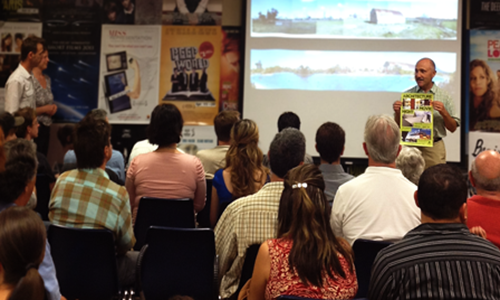How the Arts and Cultural Tourism Spur Economic Development
Craig Watson is director of the California Arts Council and can be reached at cwatson@cac.ca.gov.
It’s the question that all local officials ask themselves: How can we attract and retain profitable businesses and talented people? A key component of such efforts — and one that’s often mislabeled an “amenity” —is arts and culture.
Creative businesses play a huge part in the California economy. These businesses comprise the arts, design, digital media and other fields that utilize a creative workforce. More than 134,000 creative businesses employ 500,000 Californians, with another 100,000 freelance or part-time creative workers in the mix. In addition, the Golden State’s 4,553 arts organizations contribute $3.56 billion annually to its economy.
But the value of the arts extends beyond the direct economic impact. When Gallup and the Knight Foundation set out to answer the question “What attaches people to their communities?” in a three-year study, researchers found that the key reasons cited by residents for loving their cities were entertainment and social offerings, how welcoming the city is and its aesthetics — in other words, the arts and culture.
Creative Placemaking: “Every Mayor’s Dream”
Today’s buzzword to describe communities’ investment in arts and culture is “creative placemaking” — which means using the arts to develop an area where people want to live, work and congregate. Urban-planning researcherAnn Markusen defined this concept for the Mayors’ Institute on City Design in the white paper Creative Placemaking:
In creative placemaking, partners from public, private, nonprofit and community sectors strategically shape the physical and social character of a neighborhood, town, city or region around arts and cultural activities.
The economic impact of clustering creative businesses was explained by Jamie Bennett, director of public affairs for the National Endowment for the Arts. Bennett said, “A theater has 1,000 people show up at eight o’clock and leave at eleven o’clock. A museum might have 1,000 visitors spread out over the course of an eight-hour day. A rehearsal studio might have 30 people coming and going every hour over 12 hours. You put the three different organizations in proximity to one another and, all of a sudden, you have a full day of positive foot traffic on a street — feet that belong to people who need to eat meals, buy newspapers, go shopping and take public transportation. You have every mayor’s dream.”
The key is to treat the arts as an essential part of the city’s identity. Successful creative placemaking builds the economy at the local level, enhances surrounding non-arts businesses and provides job opportunities and ways for individuals to participate in activities associated with the arts and cultural events. The results bring people together, spark community pride and create a more vibrant “place.”
Other states are actively investing in arts and culture as a challenge to California’s historic leadership in the global creative economy. The National Governors Association (www.nga.org) examined this issue in the report New Engines of Growth: Five Roles for Arts, Culture and Design. The report notes that as technology sectors have shifted from basic engineering to the added values of innovative design and creative products, establishing a network of creative workers is vital to staying competitive.
Tap Your Local Talent.gif)
Successful creative placemaking acknowledges and supports local arts and culture. “Art and artists are the asset all communities are gifted with,” noted Carol Coletta, director of ArtPlace, a collaboration of 13 leading national and regional foundations and six of the nation’s largest banks that invests in creative placemaking. “In a time when we especially need to jump-start economic and development momentum in our communities, I have to ask, ‘Why wouldn’t you put every single asset you have available to work to make that happen?’ And that includes art and artists.”
Creative clusters that combine artists and entrepreneurs have mushroomed in California cities. In Santa Monica, an old rail yard has blossomed into the visual-art gallery complex of Bergamot Station. Originally a railway station in the 19th century, Bergamot Station functioned as a warehouse storage facility until the 1980s when the City of Santa Monica purchased it for a future use as a light-rail station. When the light-rail project stalled, the city approached a local developer and architect to create an artists’ and gallery space. It opened in 1994 and has since become a key attraction both locally and for tourists, with more than 600,000 visitors each year visiting the galleries and other businesses in the complex.
In San Francisco’s South of Market neighborhood, a handful of nonprofits teamed up with entrepreneurs to establish the 5MPlaceWorks partnership where tech entrepreneurs mix with artists and designers. These creative clusters may seem spontaneous, but are the result of direct andmeaningful planning and investment.
Yet clusters of arts, culture and entrepreneurship aren’t exclusive to major urban areas. Smaller cities can take advantage of local talent to showcase the community’s unique personality and, at the same time, provide important job training and creative interaction for local citizens.
Modesto Fosters Creative Innovation
Modesto’s new Building Imagination Center is a contemporary art and video-art venue. It’s also an education and artist residency center. Its activities, including investment in local video artists, encourage production and job training for anyone interested — mid-level professionals, recent graduates of California State University, Stanislaus, and members of the public.
The Building Imagination Center is part of a greater network of the Modesto arts and culture scene, and its monthly short documentary projects on local subjects enhance these characteristics and bring the community together, according to Jessica Gomula-Kruzic, the center’s director. The center plans to highlight other local cultural assets, such as the American Graffiti Car Show and Festival and the area’s largely unknown architectural treasures, which include buildings designed by Julia Morgan, Frank Lloyd Wright and other notable architects.
The center is not solely for professional artists and filmmakers, however. It also offers free workshops that teach individuals how to create short videos using common devices like smart phones. As technology advances, the nature of work is changing, and employers increasingly expect employees to have multimedia skills. One-minute videos for YouTube and websites are being produced by businesses from real estate to restaurants and retail. “We’re hoping to give people the skills to do those things,” said Gomula-Kruzic.
The Role of Cultural Districts
Cultural districts are zones that aggregate cultural or artistic ventures (both nonprofit and commercial) and, in the process, stimulate economic development. A dozen states nationwide have enacted official cultural-district designations, some with remarkable measurable results. An analysis of Maryland’s arts and entertainment districts notes a 17 percent growth in new jobs, goods and services, and wages from new business in the state’s arts and entertainment districts between 2008 and 2010 — a significant achievement during the recession.
Some California communities are already moving in this direction. A part of San Diego’s downtown East Village area, called the I.D.E.A. District for its focus on innovation, design, education and arts, was conceived by a pair of local developers who have partnered with higher education institutions, the San Diego Foundation, community groups and others.
“[Local governments] need to answer the question, ‘What do people want?’ Artistic, cultural and social experiences are what keep people in a community,” said David Malmuth, one of the founders of the I.D.E.A. District.
Pete Garcia, Malmuth’s partner in the I.D.E.A. District project, emphasizes the need for communities to identify their own strengths and not be swayed by what’s popular elsewhere. Cultural district supporters need to ask the question, “What is our city about? And what is it missing?”
Malmuth encourages planners and coordinators to work quickly, perhaps in small ways rather than spending too much time on long-term planning. He said, “Take too long and the community loses focus, loses enthusiasm.”
Creating an Arts Oasis
A rebirth of the creative community is under way in Palm Springs and the Coachella Valley. Palm Springs has long been a popular vacation spot for film stars. In the 1980s and ‘90s the area was better known as a retirement community than as a place of creative economic activity.
Today the creative economy is thriving in the region, notes Robert Stearns, the executive director of ArtsOasis, an initiative of the Coachella Valley Economic Partnership. Policy-makers and leaders in the area sensed that the arts and creative businesses were a strong economic driver. A study of the area, Creative California Desert, revealed that the creative economy is “a robust engine that employs nearly one out of every five persons working in the Coachella Valley and produces a raw impact of close to $1 billion per year.”
This vigorous creative activity started in small ways. The Palm Springs International Film Festival began as a modest proposal in 1989. Now, almost 25 years later, it’s a major international event that draws 140,000 visitors in a 10-day period. The festival’s success encouraged film-related businesses to set up in the area. A weekend trade show grew into the Modernism Week, a celebration of architecture and related businesses, like clean energy and design, that attracts experts worldwide. Interest in visual art, architecture, design and modern art produced art festivals and fostered a unique brand of cultural tourism, where people visit different art studios and participate in hands-on projects. The area has also been successful in attracting younger people, due in part to the success of the Coachella Valley Music and Arts Festival, a six-day event spanning two weekends.
One result of local leaders’ discussions and planning around arts and economic activity was the ArtsOasis website (http://artsoasis.org), which lists the regional arts-related activities in a single comprehensive resource to help facilitate event planning and cultural tourism. Another result is the development of a creative marketplace and trade center for talent, services and products — initially for film and media workers, but with the goal of expanding to other creative industries.
Stearns sees this collaboration as a key way to build the creative economy during tough economic times. “It doesn’t take a lot of infrastructure money for this community,” he said. “Building the creativeeconomy requires building the creative community.”
The first step, according to Stearns, is to determine exactly who is in the local creative community. “If you look at the broad field, you may see there is a much bigger world than the ‘starving artists’ and the nonprofits,” he said. While the traditional arts play a very big role, they are only part of the overall creative economy. If your community is home to creative businesses or related industries, invite them to participate and include them in your city’s creative placemaking efforts.
Pasadena and Levitt Pavilions Partner to Revitalize Area, Create Festivals
While local governments are strapped for funding, public-private partnerships can be instrumental in building the creative economy, and Levitt Pavilion in Pasadena offers a great example.
Levitt Pavilions is a national nonprofit whose goal is bringing communities together through music. To qualify for its support, a city must make available a publicly owned space and commit to at least 50 free music concerts annually. Levitt Pavilions provides capital seed funding to renovate or build a music venue, and a local “Friends of the Levitt Pavilion” nonprofit must be formed. In addition, the local government maintains the location.
The first Levitt Pavilion project, other than one in the founders’ hometown in Connecticut, was the band shell in Pasadena’s Memorial Park. The park was run-down and suffering from the effects of crime, vagrant drug use, homelessness, graffiti and under use. Levitt Pavilions provided approximately $250,000 in capital seed funding plus annual operating support to improve the band shell for public concerts, the local “friends of” nonprofit raised the additional funds (about $1.5 million), and an annual music program for the community was born.
The free concerts are a vital part of the Levitt Pavilion model. By hosting the community events, the venue becomes a destination in the city for people from all socioeconomic backgrounds, especially families. “It brings out the entire community,” said Vanessa Silberman, director of communications for Levitt Pavilions. “There’s a sense of neighborliness — a nice small-town feel in a city.”
The turnaround for the area in Pasadena is significant, said Silberman. Nearby Colorado Boulevard in the center of Pasadena’s original downtown had undergone a revitalization, evolving into the extremely popular Old Pasadena area. Prior to the Levitt Pavilion investment, local residents avoided Memorial Park because of the crime problem. Now the area around the park has become as vibrant as Colorado Boulevard, with new condominiums, restaurants and other amenities nearby.
The success of the Levitt Pavilion partnership is due to the long-term commitment of the city, the local nonprofit and the national Levitt organization.
In conjunction with the Levitt Pavilion project, Pasadena launched an annual music festival called Make Music Pasadena. Now in its sixth successful year, Make Music Pasadena presents Grammy Award-winning musicians and top recording artists performing blues, jazz, folk, alternative rock and more. The festival’s eclectic mix of music appeals to audiences of all ages and has earned it high praise. It’s been dubbed by L.A. Weekly as “Los Angeles’ best free festival.” More than 30,000 fans flock to Pasadena to hear 500 musicians performing 140 free concerts on 35 stages spread throughout the city — all in one music-filled day.
Your Town, Your Arts
Enhancing the creative sector is essential to the future of the Golden State. But investing in the arts doesn’t necessarily need to strain the pocketbooks of local governments or require extra staff. Assess what is already in your own community. Assist and support the local businesses, nonprofits and residents who propose innovative projects. Invite creative leaders to share ideas, and encourage high-quality proposals that can make a real difference. A little investment in the arts can go a long way toward keeping your community on the forefront of the creative economy.
Creative Placemaking Resources
Resources and funding opportunities for cities interested in investing in creative placemaking are listed below.
- Our Town grants from the National Endowment for the Arts (www.arts.gov). Organizations may apply for creative placemaking projects that contribute to the livability of communities and place the arts at their core.
- ArtPlace funding (www.artplace.org). ArtPlace works to accelerate creative placemaking through grants and loans, partnerships, solid and imaginative research, communication and advocacy.
- Creating Places of Vitality grants from the California Arts Council (www.arts.ca.gov) . This program targets rural and underserved communities in California by supporting partnerships and cultural activities that create a distinct sense of place.
- Various websites consolidate hundreds of grant opportunity listings. These includewww.California.grantwatch.com, www.foundationcenter.org, and www.arts.ca.gov (see opportunities/grants).
California communities have plenty of creative assets, both large and small, that can be utilized even in this tough economy. The California Arts Council website (www.arts.ca.gov) lists hundreds of festivals throughout the state that demonstrate our will and desire to have arts in our communities. Local governments may be strapped, but a small investment in the arts and creative communities can have a huge impact in the long run. |
This article appears in the May 2013 issue of Western City
Read the full article here: www.westerncity.com
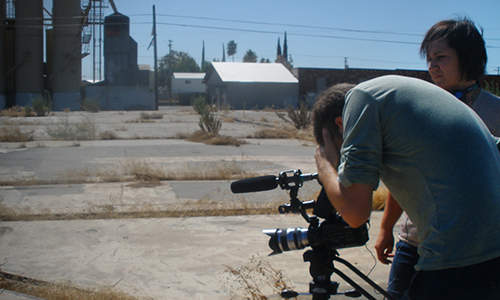
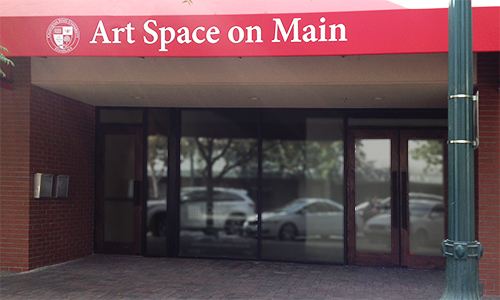


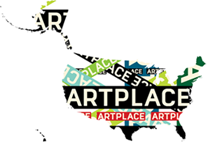
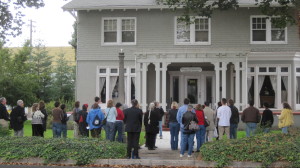
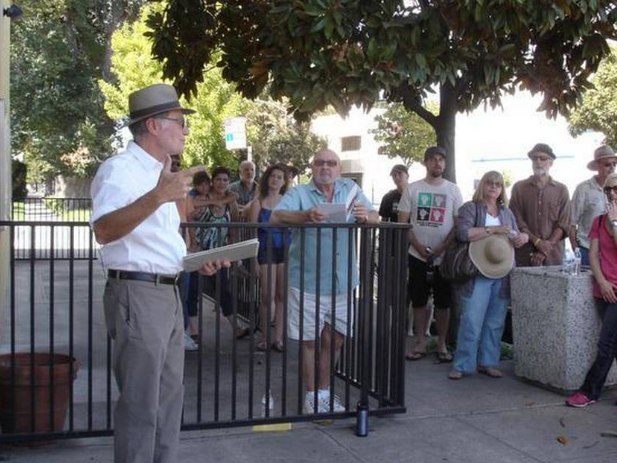
 Few Modestans realize that in the mid-20th century, the city attracted some of the most famous architects and landscape designers in the country. Their work was lauded nationally and featured in books published by New York’s Museum of Modern Art.
Few Modestans realize that in the mid-20th century, the city attracted some of the most famous architects and landscape designers in the country. Their work was lauded nationally and featured in books published by New York’s Museum of Modern Art.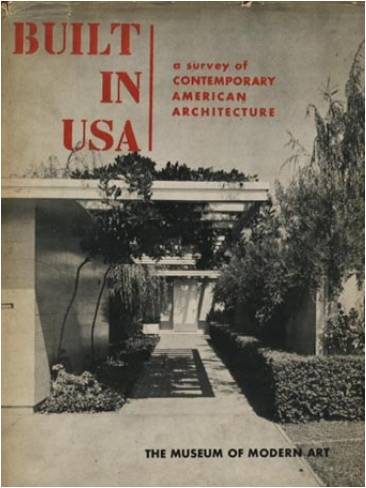

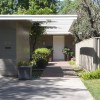 In the middle decades of the 20th century, the Modernist architecture of Modesto, California, was on the cutting edge of environmental and artistic design and it received national attention. In the 1940s, the New York Museum of Modern Art published three books featuring Modesto architecture and a photo of a Modesto home was on the cover of the catalogue for its trend-setting 1944 exhibition on modern architecture. From the 1940s through the 1960s, many books, professional journals, and popular magazines published articles on Modesto buildings. The city’s national stature in architecture began with the Heckendorf House designed by John Funk in 1939, but many more significant pieces of architecture were built in the following years.
In the middle decades of the 20th century, the Modernist architecture of Modesto, California, was on the cutting edge of environmental and artistic design and it received national attention. In the 1940s, the New York Museum of Modern Art published three books featuring Modesto architecture and a photo of a Modesto home was on the cover of the catalogue for its trend-setting 1944 exhibition on modern architecture. From the 1940s through the 1960s, many books, professional journals, and popular magazines published articles on Modesto buildings. The city’s national stature in architecture began with the Heckendorf House designed by John Funk in 1939, but many more significant pieces of architecture were built in the following years.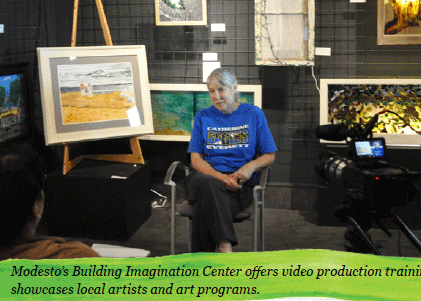

.gif)





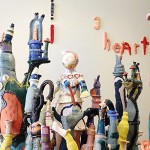 The Building Imagination Center is a visual arts and media hub in downtown Modesto. Working with the Modesto Art Museum, the Center provides the community with a visual arts gallery for world class photography, sculpture, paintings, and contemporary art mediums, such as video, animations, and interactive content.
The Building Imagination Center is a visual arts and media hub in downtown Modesto. Working with the Modesto Art Museum, the Center provides the community with a visual arts gallery for world class photography, sculpture, paintings, and contemporary art mediums, such as video, animations, and interactive content.